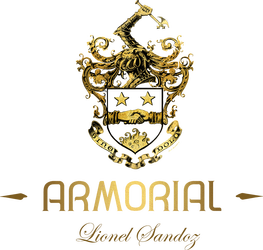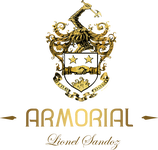DESCRIPTION
SCHECK
Tyrol
Autriche
Les "Sheck" sont connus et cités à plusieurs reprises aux XVe et XVIe siècles par l'archiduc Ferdinand II du Tyrol dans son ouvrage "Histoire de son gouvernement et de ses terres...1885".
Cette famille est mentionnée à Grossengersdorf en Basse-Autriche au XVIIIe siècle.
Armoiries:
" D'or, à un loup rampant de gueules. "
- Cimier: le loup, issant.
Sources héraldiques:
- Armorial d'Europe par J.B.Rietstap (Gouda, 1884, Berlin, 1934) (Gouda, 1887, Berlin 1937).
- Armorial général J.B. Rietstap illustré par Victor et Henri Rolland (1903-1926). Colorisé par Lionel Sandoz (1993-2002).
Etymologie:
Scheck désignait un homme qui portait une cotte de mailles, une armure, une cuirasse, de l'ancienne langue du moyen-haut-allemand "schecke".
Note:
- 27 septembre, 1358, Vienne. Jean de Tyrna, monnayeur, comparaît comme témoin lors de la vente d'une maison du chevalier Niklas Scheck à Vienne au chancelier du duc Rudolf Johann von Platzheim.
- Jakob Scheck, docteur en médecine, a reçu une lettre d'armoiries de Ferdinand I., roi des Romains, le 29 mai 1550 à Vienne (Autriche). Ferdinand I., frère aîné Charles Quint, fut Empereur du Saint-Empire, 1556-1564. D'après le diplôme impérial, Jakob Scheck était professeur public à Tübingen, ville universitaire allemande, située au centre du Land de Bade-Wurtemberg. Ses armoirie était à l'époque : " D'or, à la bande de sable. "
Souces bio-bibliographiques:
- Erzherzog Ferdinand II. von Tirol. Geschichte seiner Regierung und seiner Länder, par Josef Hirn, Ferdinand II. archduke of Tyrol, 1885.
- Neue zeitschrift des Ferdinandeums fur Tirol und Vorarlberg, par Tiroler Landesmuseum Ferdinandeum, 1896.
______________________________________
SCHECK
Tirol
Niederösterreich
Österreich
Bekannt und mehrfach zitiert sind die „Sheck“ im 15. und 16. Jahrhundert von Erzherzog Ferdinand II. von Tirol in seinem Werk „Geschichte seiner Regierung und seiner Ländereien...1885“.
Diese Familie wird im 18. Jahrhundert in Grossengersdorf in Niederösterreich erwähnt.
Wappen:
" Golden, zu einem kriechenden roten Wolf."
- Helmzier: der Wolf kommt aus dem Helm
Heraldische Quellen:
- Arms Book of Europe von J. B. Rietstap (Gouda, 1884, Berlin, 1934) (Gouda, 1887, Berlin 1937).
- Allgemeine Heraldik J. B. Rietstap illustriert von Victor und Henri Rolland (1903-1926). Koloriert von Lionel Sandoz (1993-2002).
Etymologie:
Scheck bezog sich auf einen Mann, der Kettenhemd, Rüstung, Kürass trug, vom altmittelhochdeutschen "schecke".
Notieren:
- 27.09.1358, Wien. Jean de Tyrna, Münzmeister, tritt als Zeuge beim Verkauf eines Hauses des Ritters Niklas Scheck in Wien an den herzoglichen Kanzler Rudolf Johann von Platzheim auf.
- Jakob Scheck, Doktor der Medizin, erhält am 29. Mai 1550 in Wien (Österreich) einen Adelsbrief mit Wappen von Ferdinand I., König der Römer. Ferdinand I., älterer Bruder Karls V., war von 1556 bis 1564 Kaiser des Heiligen Römischen Reiches. Jakob Scheck war laut Kaisergrad öffentlicher Professor in Tübingen, einer deutschen Universitätsstadt im Zentrum des Landes Baden-Württemberg.
Sein Wappen lautete damals: "Golden mit schwarzem Schrägstrich.".
Biobibliografische Quellen:
- Erzherzog Ferdinand II. von Tirol. Geschichte seiner Regierung und seiner Länder, von Josef Hirn, Ferdinand II. Erzherzog von Tirol, 1885.
- Neue Zeitschrift des Ferdinandeums für Tirol und Vorarlberg, Tiroler Landesmuseum Ferdinandeum, 1896
______________________________________
SCHECK
Tirol
Austria
The "Sheck" are known and cited several times in the 15th and 16th centuries by Archduke Ferdinand II of Tyrol in his work "History of his government and his lands...1885".
This family is mentioned in Grossengersdorf in Lower Austria in the 18th century.
Coat of arms:
“ Or, to a rampant wolf Gules.
- Crest: the wolf, issuant.
Sources :
- Armorial of Europe by J.B.Rietstap (Gouda, 1884, Berlin, 1934) (Gouda, 1887, Berlin 1937).
- Armorial general J.B. Rietstap illustrated by Victor and Henri Rolland (1903-1926). Colorized by Lionel Sandoz (1993-2002).
Etymology:
Scheck referred to a man who wore chainmail, armour, cuirass, from Old Middle High German "schecke".
To note:
- 27.09.1358, Vienna. Jean de Tyrna, mint master, appears as a witness at the sale of a house from the knight Niklas Scheck in Vienna to the ducal chancellor Rudolf Johann von Platzheim.
- Jakob Scheck, doctor of medicine, received a letter of arms from Ferdinand I, king of the Romans, on May 29, 1550 in Vienna (Austria). Ferdinand I., elder brother Charles V, was Holy Roman Emperor, 1556-1564. According to the imperial diploma, Jakob Scheck was a public professor in Tübingen, a German university town, located in the center of the Land of Baden-Württemberg.
Its coat of arms at the time was: “ Or, with a bend, sable ".
Bio-bibliographic sources:
- Erzherzog Ferdinand II. von Tirol. Geschichte seiner Regierung und seiner Länder, by Josef Hirn, Ferdinand II. Archduke of Tyrol, 1885.
- Neue zeitschrift des Ferdinandeums fur Tirol und Vorarlberg, by Tiroler Landesmuseum Ferdinandeum, 1896
________________________________________
SCHECK
Tirolo
Austria
Gli "Sheck" sono conosciuti e citati più volte nei secoli XV e XVI dall'arciduca Ferdinando II del Tirolo nella sua opera "Storia del suo governo e delle sue terre...1885".
Questa famiglia è menzionata a Grossengersdorf nella Bassa Austria nel XVIII secolo.
Stemma:
" D'oro, a un lupo rampante di rosso."
- Cimiero: il lupo, emittente.
Fonti:
- Armorial of Europe di J.B.Rietstap (Gouda, 1884, Berlino, 1934) (Gouda, 1887, Berlino 1937).
- Armorial generale J.B. Rietstap illustrato da Victor e Henri Rolland (1903-1926). Colorato da Lionel Sandoz (1993-2002).
Etimologia:
Scheck si riferiva a un uomo che indossava cotta di maglia, armatura, corazza, dall'antico tedesco medio alto "schecke".
Nota:
- 27/09/1358, Vienna. Jean de Tyrna, maestro di monete, appare come testimone durante la vendita di una casa del cavaliere Niklas Scheck a Vienna al cancelliere ducale Rudolf Johann von Platzheim.
-Jakob Scheck, dottore in medicina, ricevette una lettera d'armi da Ferdinando I., re dei Romani, il 29 maggio 1550 a Vienna (Austria). Ferdinando I., fratello maggiore Carlo V, fu Sacro Romano Imperatore, 1556-1564. Secondo il diploma imperiale, Jakob Scheck era professore pubblico a Tubinga, città universitaria tedesca, situata al centro del Land del Baden-Württemberg.
Il suo stemma era all'epoca: " D'oro, con una banda di nero ".
Fonti bio-bibliografiche:
- Erzherzog Ferdinando II. von Tirolo. Geschichte seiner Regierung und seiner Länder, di Josef Hirn, Ferdinando II. Arciduca del Tirolo, 1885.
- Neue zeitschrift des Ferdinandeums fur Tirol und Vorarlberg, del Tiroler Landesmuseum Ferdinandeum, 1896
______________________________________
SHARE ON SOCIAL NETWORKS
OPINIONS
There are no notes at this time. Be the first to rate!
GIVE A NOTE








